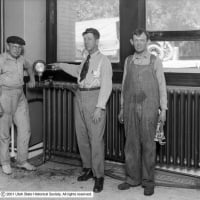Welcome! Here are the website rules, as well as some tips for using this forum.
Need to contact us? Visit https://heatinghelp.com/contact-us/.
Click here to Find a Contractor in your area.
DIY Heatloss Calculations
Perry_2
Member Posts: 381
Along with looking at the basement and the attic - you need to find a way to look at how the outside walls were constructed. At your age you could have no insulation, 2" rockwool, or 3.5" fiberglass (assuming 2x4 construction). This is clearly worth knowing and you can then make plans for additional insulation if you have no insulation.
I presume the boiler is in the basement. It is possible that the radiant heat from the boiler is the heating source for the basement. Something to consider.
I live in a house about 10 years older than yours - and put up beadborad (it breaths) and studs in the basement and it made a huge difference. Do not seal the beadboard joints - do not cover with plastic. You want the insulation to breath so that moisture moves and does not collect - otherwise you will likely get mold. I also run a dehumidifier in the basement as well - spring, summer, and fall.
If you have a monoflo T system with cast iron baseboard this is a perfect application for the right mod/con boiler. I just changed out my old craneline boiler with a Vitodens 200.
Best of luck with your new house.
Perry
I presume the boiler is in the basement. It is possible that the radiant heat from the boiler is the heating source for the basement. Something to consider.
I live in a house about 10 years older than yours - and put up beadborad (it breaths) and studs in the basement and it made a huge difference. Do not seal the beadboard joints - do not cover with plastic. You want the insulation to breath so that moisture moves and does not collect - otherwise you will likely get mold. I also run a dehumidifier in the basement as well - spring, summer, and fall.
If you have a monoflo T system with cast iron baseboard this is a perfect application for the right mod/con boiler. I just changed out my old craneline boiler with a Vitodens 200.
Best of luck with your new house.
Perry
0
Comments
-
Really...who doesn't what to know why...?
I just moved my two and four legged family into a 44 year old split level home in Iowa with baseboard radiators. We still have the original 44 year old boiler (still going strong but WOW!!! what a waste of energy...hot to the touch...wrapped it right away when I saw felt that).
We'll be doing some remodeling in the next year or so and that boiler will be on the hit list for sure...to be replaced by I'm not sure what yet...but that's not of interest to me right now...too early in our planning stage for that and there are bigger fish to fry beforehand.
In any case I am just barely savvy enough to know (and have seen confirmed many times on threads in this and other forums) is that the three most important rules of heating and cooling efficiency is envelope, envelope and envelope!!! If our plans go as expected then I'll have the opportunity to do some relatively easy upgrades to our envelope in many locations if not all over the home through the course of our remodeling.
OK now the point of this post. Does any kind soul know a good and accurate method of determining (preferrably by actual measurement) what the actual heatloss is by room of a home without knowing anything about the insulation type, thickness, coverage etc... Seems to me that it would be difficult if you can't thermally isolate rooms and efectively get rid of the convective room to room interaction. Also seems like you would need to track the outdoor temperature vs. indoor temperature over time and apply that to some formula or do it when you know the outdoor air temperature isn't changing much over the course of a couple hours and there's no wind...I must be making this too complicated...?
Thanks in advance for your comments!0 -
At the top of the page, click on heat loss calcs. It will get you a free heat loss program that will walk you through all the steps. Your outdoor temp is the coldest day you will see. Then enter the indoor temp you wish to reach. You will need to peek up in the attic, and look around the basement. Measure through an open window for wall thickness...whatever you need to do. My mom is from Mitchelville IA and was born in Zookspur. Her family is still there. Also in Madrid. My grandpa settled there to mine coal and ended up farming....corn....Go Hawkeyes!!!
TimJust a guy running some pipes.0 -
to know
I suggest getting a home energy pro to do a blower door test and use an IR camera to assess heat loss through the building. Well worth the money to guide how you prioritize envelope upgrades. David Goldman, a HO who contributes here, has recently posted a bunch of pics and discussion that are very instructive. Between that and a good heat loss calculation, you can size the new boiler to what you will need at the end of the remodeling. Good luck.0
This discussion has been closed.
Categories
- All Categories
- 86.3K THE MAIN WALL
- 3.1K A-C, Heat Pumps & Refrigeration
- 53 Biomass
- 422 Carbon Monoxide Awareness
- 90 Chimneys & Flues
- 2K Domestic Hot Water
- 5.4K Gas Heating
- 100 Geothermal
- 156 Indoor-Air Quality
- 3.4K Oil Heating
- 63 Pipe Deterioration
- 917 Plumbing
- 6.1K Radiant Heating
- 381 Solar
- 14.9K Strictly Steam
- 3.3K Thermostats and Controls
- 54 Water Quality
- 41 Industry Classes
- 47 Job Opportunities
- 17 Recall Announcements
